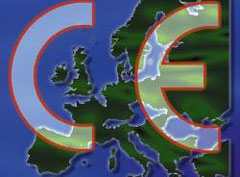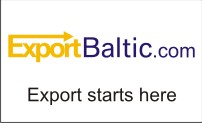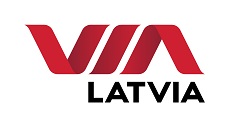Analytics, EU – Baltic States, Legislation, Markets and Companies
International Internet Magazine. Baltic States news & analytics
Saturday, 05.04.2025, 13:04
New EU legislation on “CE marking”
 Print version
Print versionThe CE marking is required for many products in the EU and the European Economic Area "EEA", which includs Iceland, Liechtenstein and Norway. It shaws that the product is assessed before being placed on the market and meets EU safety, health and environmental protection requirements. The European Commission (in the DG on Industry) provides economic operators and consumers with information on how the process of affixing the CE marking on a product works, showing that the manufacturer has taken all necessary measures to ensure that the final product complies with numerous safety rules.
CE marking: general review
 |
|---|
CE marking is becoming mandatory only for the products that are covered by the scope of one or more of the so-called “new approach” from 1985 and shall be affixed with it in order to be placed on the EU market. Examples of products that fall under the mew approach are toys, electrical products, machinery, personal protective equipment, lifts, etc. Products that are not covered by CE marking legislation shall not bear the CE marking. (Brussels, 15 June 2010, MEMO/10/257).
The new legislation on EU trade mark provides for the appropriate control of testing laboratories and certification bodies, and –which is more important – sets out a Union’s policy on surveillance of products on the market and of effective controls of products from third countries.
Community’s legislation on product’s quality was completely renewed by the “new approach” (introduced initially in 1985), which has become a role model for the EU “better regulation” approach. The legislation introduced a certain level of protection that must be achieved though did not specify a particular choice of technical solutions to achieve it.
On 15 June 2010, the new directive was adopted to cover a large proportion of products marketed in the EU in more than 20 industrial sectors, including electro-technical products, machinery, radio/telecoms equipment, toys, medical devices, construction products and high-speed rail systems. It is estimated that the trade in products covered by the major manufacturing sectors covered by the directive is in excess of € 1.500 bln per year.
On the Commission’s website (Enterprise and Industry), main information on CE marking can be found, concerning the CE use for professionals and consumers.
See: http://ec.europa.eu/enterprise/policies/single-market-goods/cemarking
Improving the understanding of CE marking
The CE marking is required for specific product categories and indicates that such products meet EU safety, health or environmental requirements. It guarantees the free movement of safe products within the European market and is a key indicator of a product’s compliance with EU legislation.
Manufacturers in the EU are affixing the CE marking to its products. By placing CE marking on a product, they declare the product’s conformity with the applicable EU legal requirements. The manufacturer (under his sole responsibility) has to verify that the goods he is selling comply with all relevant legislations or – if necessary – has to have it examined by a notified conformity assessment body for that purpose.
Not all products sold in the EU need to bear CE marking. CE marking applies to 24 different product categories, ranging from electrical equipment to toys and from explosives to medical devices. Each product falls under one or more Directives, which determine the specific requirements that the product must meet in order to be CE-marked. Only the product categories subject to specific directives are required to be CE marked.
Wholesalers and retailers also bear some responsibility: they must verify that all the goods they distribute which require a CE marking are actually carrying one and that the necessary controls have been carried out.
In order to avoid non-conformity abuses, legal measures and economic sanctions have been established to deter the vast majority from doing so.
Six steps to obtain the CE marking
To comply with legal requirements, manufacturers have to follow six necessary steps in order to make their products –with a EU trade mark affixed – ready for the market:
- Identify the directive(s) and harmonised standards applicable to the product. The essential requirements products have to fulfill (e.g. safety) are harmonised at EU level and are set out in general terms in the new directive. Harmonised European standards are issued with reference to the applied directives and express in detailed technical terms the essential requirements.
- Verify the product-specific requirements. It is up to manufacturer to ensure that his product complies with the essential requirements of the relevant EU legislation. Full compliance of a product to the harmonised standards gives to the product the “presumption of conformity” with the relevant essential requirements. The use of harmonised standards remains voluntary as manufacturers may decide to choose other ways to fulfill the essential requirements.
- Identify whether an independent conformity assessment is required from a Notified Body. Each directive covering a particular product specifies whether an authorised third party (Notified Body) must be involved in the conformity assessment procedure necessary for CE marking.
- Test the product and check its conformity to the EU legislation. One part of the procedure is a risk assessment. By applying the relevant harmonised European standards, the manufacturer will be able to fulfill the essential legislative requirements of the directives.
- Draw up and keep available the required technical documentation. The manufacturer has to establish the technical documentation required by the Directive(s) for the assessment of the product’s conformity to the relevant requirements and a risk assessment. Together with the EC declaration of conformity, the technical documentation must be presented on request to the competent national authorities.
- Affixing the CE mark to the product and the EC Declaration of Conformity. The manufacturer, according to its legal format, must affix the CE marking visibly, legibly and indelibly to the product or its data plate. If a Notified Body was involved in the production control phase, its identification number must also be displayed.
Improved coherence and comparability of designation, operation and monitoring of Notified Bodies
New legislation requires in certain circumstances that products are certified by third parties before being placed on the market. These third parties (so far 1800 in the EU) are laboratories, inspection and certification bodies which are known generally as conformity assessment bodies, or more formally as “Notified Bodies”. Member States have the responsibility to decide which of their conformity assessment bodies fulfill the necessary criteria to become notified since not all do. The minimum criteria include competence, impartiality, integrity, etc.
Notified bodies are private companies and operate in a competitive market. Whilst this can be good for the manufacturer, it can lead to unfair practices and less rigorous implementation of costly procedures, by those seeking to bend the rules. Also, different notified bodies may take different approaches when carrying out their work. This represents, not only a risk of unsafe products on the market, but also distorts competition within the manufacturing industry.
Unfortunately, Commission argued, some member states have more stringent criteria than others for designation of Notified Bodies, which results in an uneven playing field in Europe. Accreditation has become a formal system to provide for an independent attestation of the competence, impartiality and integrity of conformity assessment bodies.
Accreditation bodies are organised in the EU into the European co-operation for Accreditation (EA). It ensures that the member states’ accreditation bodies work according to the same requirements, so that accreditation granted from one body is directly comparable to that granted from another. However, not all European accreditation bodies are members of EA and not all Notified Bodies undergo accreditation.
The New Legislative Framework for the free movement of goods therefore provides for:
- the decentralised competence assessment and monitoring of Notified Bodies under the responsibility of each Member State;
- a legal framework for accreditation and co-ordination at EU level using the existing organisation of EA as a foundation for this.
This will provide the EA with public recognition and provide it with the authority it currently lacks to provide accreditation services to all Notified Bodies. It will also ensure that all EU member states use accreditation as a basis of notification.
Common EU legal framework for market surveillance
The enforcement of product safety legislation is an important task; not only to protect consumers and other users from unsafe products but also to ensure a level playing field for reputable businesses. In the EU market, surveillance is the responsibility of the member states.
With the RAPEX system (see: 2009 Annual RAPEX Report) the EU has an effective and efficient system in place to share information about dangerous products found on the European market.
At the same time, however, the devolved nature of enforcement responsibility means that in practice surveillance efforts are still largely guided by national priorities, risk assessments can diverge significantly for the same product, as do measures and penalties.
Moreover, the effect of continuing globalisation, with more and more products coming into the EU's internal market from third countries, is making it increasingly difficult to justify a purely national approach to enforcement. The nature of the EU internal market, combined with the effects of global supply chains, makes it necessary to adopt a truly coordinated approach to market surveillance. Despite significant progress in recent years, such cooperation has not yet become a reality.
Therefore, the new legislation allows flexibility of organisation at national level, to take account of national conditions whilst establishing specific minimum requirements for CE operation.
It also foresees the extension of the existing co-operation mechanisms (it builds upon the existing national structures), improves the traceability of products and clarifies the obligations for all economic operators, i.e. manufacturers, distributors, and importers, etc.
More information:
- The new legislative framework
- http://www.ec.europa.eu/cemarking








 «The Baltic Course» Is Sold and Stays in Business!
«The Baltic Course» Is Sold and Stays in Business!

